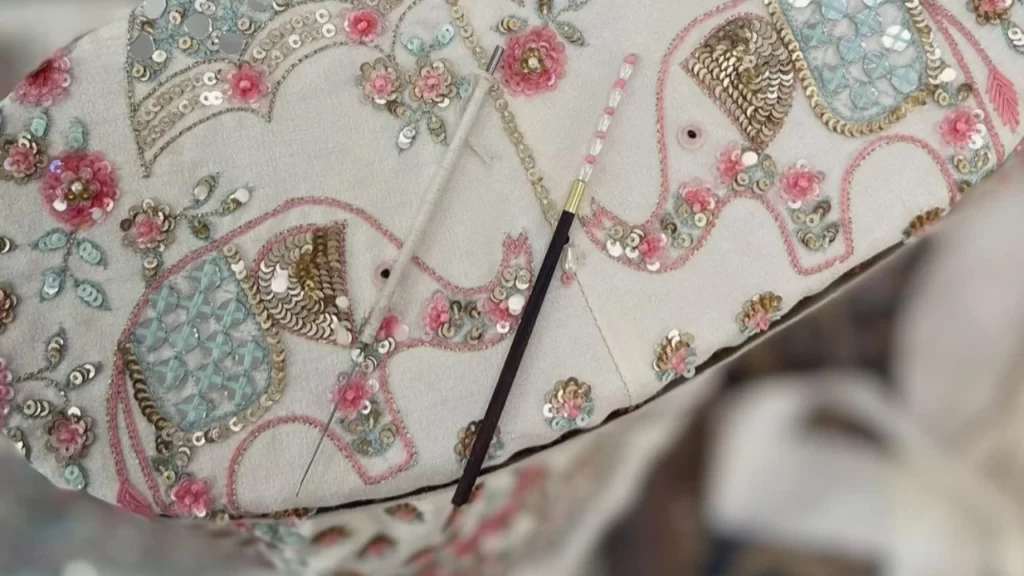Embroidery, a timeless form of artistry, has adorned sarees for centuries, lending them elegance, depth, and cultural significance. The intricate designs created by skilled artisans through hand embroidery techniques elevate the allure of these traditional garments. From the roots of ancient civilizations to the contemporary fashion scene, here’s a journey through some of the most popular hand embroidery techniques used in sarees.

Chikankari Embroidery
Chikankari, with its delicate white threadwork, adds an air of elegance to sarees. This art form, originating in Lucknow, often graces fabrics like cotton, georgette, and chiffon. Its subtle beauty shines on pastel-colored sarees, making it a perfect choice for light and breezy fabrics.
- Process: Originating in Lucknow, India, Chikankari involves delicate white threadwork on fabrics like cotton, georgette, and chiffon. It typically features floral and intricate patterns, with stitches like the “shadow work” creating a unique effect.
- Origin: The Mughal era inspired Chikankari, blending Persian aesthetics with Indian craftsmanship.
- Trivia: Chikankari is often done on pastel-colored fabrics to enhance the elegance of the embroidery.
- Sub-Types: Phanda (knot stitch), Murri (seed stitch), and more.
- Best for Sarees: Chikankari works beautifully on light fabrics like georgette and chiffon, adding a touch of sophistication to your ensemble.
Zardozi Embroidery
Zardozi embroidery exudes opulence with its use of gold or silver threads, pearls, sequins, and gemstones. This intricate technique hails from Persia and found its glory during the Mughal era. Ideal for silk and velvet sarees, Zardozi adds a regal touch to the fabric, making it a go-to choice for grand occasions.
- Process: Zardozi, an opulent form of embroidery, uses gold or silver threads, along with sequins, pearls, and gemstones. The process involves intricate hand stitching and embellishments.
- Origin: Zardozi finds its origins in Persia and became popular during the Mughal era in India.
- Trivia: This technique adds a regal touch to sarees, often making them the choice for grand occasions.
- Sub-Types: A variant called Abla involves attaching small pieces of mirrors to the fabric.
- Best for Sarees: Zardozi embroidery shines on fabrics like silk and velvet, turning your saree into a work of art.
Kantha Embroidery
Kantha embroidery, rooted in West Bengal, involves running stitch patterns that create intricate designs. This technique beautifully repurposes old sarees into unique creations. Kantha thrives on cotton and silk fabrics, adding a rustic yet charming element to the saree.
- Process: Hailing from West Bengal, Kantha involves running stitch patterns that create intricate designs. Old saris are stacked and stitched together, resulting in a quilt-like effect.
- Origin: Rural women in Bengal traditionally used Kantha to repurpose old fabrics into functional items.
- Trivia: Kantha embroidery brings a rustic charm to sarees and is often paired with lightweight fabrics.
- Sub-Types: Sujani Kantha, Lep Kantha, and Archilata Kantha, each with distinct techniques.
- Best for Sarees: Choose Kantha for cotton or silk sarees to add a unique, handcrafted element to your look.
Aari Embroidery
Aari embroidery is characterized by its fine chain stitch designs created using a hooked needle. Originating in North India, this technique is meticulous and adds a level of intricacy to the fabric. Ideal for silk sarees, Aari embroidery enhances their richness and often features elaborate designs suitable for festive occasions.
- Process: Aari work involves a hooked needle (aari) that creates intricate chain stitch designs on the fabric. The process is meticulous and results in fine details.
- Origin: Hailing from North India, Aari embroidery is a traditional technique passed down through generations.
- Trivia: Aari embroidery boasts symmetry and finesse, making it a favorite for bridal and festive sarees.
- Sub-Types: Aari Zardozi combines Aari and Zardozi techniques, enhancing the embroidery.
- Best for Sarees: Aari embroidery enhances the richness of silk sarees and is ideal for those seeking elaborate and artistic designs.
Mirror Work Embroidery
Also known as Shisha embroidery, mirror work involves attaching small mirror pieces to the fabric. It adds vibrancy and playfulness to sarees, often creating a fusion of traditional and contemporary styles. Mirror work is versatile and complements various fabrics, allowing sarees of different textures to sparkle.
- Process: Also known as Shisha embroidery, this technique involves attaching small mirror pieces to the fabric using decorative stitching.
- Origin: Mirror work can be traced back to various cultures, including India, Central Asia, and the Middle East.
- Trivia: Mirror work adds vibrancy and a touch of playfulness to sarees, often used in combination with other embroidery techniques.
- Sub-Types: The size and shape of mirrors, as well as the way they are attached, can vary.
- Best for Sarees: Mirror work complements a variety of fabrics, from traditional cotton to contemporary georgette, creating a fusion of styles.
Choosing the Right Embroidery for Sarees
Each embroidery technique offers a distinct charm, and the choice depends on your personal style and the occasion. For grand festivities, Zardozi or Aari embroidery can add a regal touch, while Chikankari and Kantha work beautifully for casual and semi-formal events. Mirror work and Zardozi are versatile options that blend seamlessly with various saree fabrics, elevating your ensemble.
In the vibrant world of hand embroidery, each stitch tells a story of tradition, culture, and artistry. Whether you’re drawn to the opulence of Zardozi or the subtlety of Chikankari, these techniques infuse sarees with a touch of timeless elegance, making every drape a masterpiece of craftsmanship.
